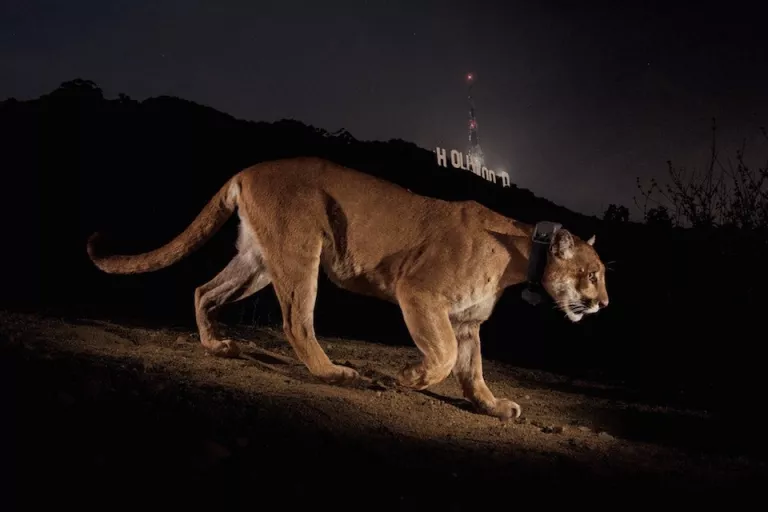
Griffith Park in Los Angeles is one of the largest urban parks in North America, and arguably one of the wildest. Here's how you can help keep it that way.
A haven for both hikers and wildlife alike, including the famous P-22 mountain lion, Griffith Park is a green gem in the middle of urban Los Angeles. This public space is free and open to all, no matter their economic status or outdoor experience. It’s heavily used by both locals seeking the solitude of nature and tourists seeking that same nature, along with some epic views of the city and Hollywood Sign.
While development exists around the outskirts of Griffith Park (such as the LA Zoo, Greek Theater, and Griffith Observatory), the vast, wild middle of the park is relatively untouched. Now, a proposal for an aerial tram threatens to change that.
An aerial tram cutting through the middle of Griffith Park to the Observatory and/or Hollywood Sign, along with plans for a potential visitor center and a viewing platform at the top of Mount Lee near the sign, would irreversibly harm the largely natural landscape. It would create an overwhelming influx of visitors to quieter areas of the park that have been painstakingly preserved, altering wildlife patterns and adding new fire dangers to a very dry section of the Santa Monica Mountains.
A mechanical aerial tramway speeding above hikers also flies in the face of the park’s mission. Griffith Park has been preserved because in 1896, Colonel Griffith donated the Park to the citizens of Los Angeles as “a place of recreation and rest for the masses.” By creating a ticketed-only attraction in the middle of a city park, this aerial tram would turn this very public space that is intended for all Angelenos and other visitors, into a park only for those who can afford it.
We count on every Angeleno to help preserve our green spaces for all to enjoy. Join the petition to stop the Hollywood Sign Aerial Tram, and keep Griffith Park wild:
Resolution On Proposed Griffith Park Tram/Skyway:
The Sierra Club Angeles Chapter opposes any proposed aerial trams into or within Griffith Park.(Adopted September 2018)
More Background Information:
In 1896, Colonel Griffith donated the Park to the citizens of Los Angeles as “a place of recreation and rest for the masses.” He envisioned the Park as an oasis for residents and visitors to reconnect with nature. Today the Park is used by a diverse set of Angelenos, for hiking, bicycling, picnicking, and more. The Park is also the largest natural wilderness within the City of Los Angeles parks department, containing a diverse ecosystem that houses a substantial number of native plant and animal species who rely on it to survive, including the world famous urban mountain lion, “P-22”.& The Park is designated a Significant Ecological Area by the County of Los Angeles General Plan and a wildlife corridor linking the Santa Monica Mountains to the Verdugo Mountain range. It is considered one of 34 biodiversity hotspots for conservation worldwide by Conservation International. As such, the Park requires special consideration whenever its flora and fauna are threatened.
Previous proposals for aerial trams in the Park have been criticized by environmentalists and others. In 2005, a draft of a Griffith Park Master Plan including two proposed aerial trams was widely criticized for how it would despoil and commercialize the Park. The Griffith Park Working Group, created in response to that plan, ultimately asserted that the Park should maintain its Urban Wilderness Identity.
However, the 2018 Dixon Report (“Comprehensive Strategies Report: Improving Access, Safety, and Mobility Around Griffith Park & the Hollywood Sign”), commissioned by Councilmember David Ryu’s office and focusing on ways to alleviate problems associated with people trying to visit or view the Hollywood Sign, mentions the possibility of an aerial tram from one of several locations in the north or northeast parts of the Park (the Headworks Reservoir, the LA Zoo, and the Wilson and Harding Golf Course) to a Hollywood Sign viewing platform somewhere in the park. In a June 2018 evaluation of the Dixon Report strategies, Recreation and Parks General Manager Mike Shull and City Council Legislative Analyst Sharon Tso rated the aerial tram strategy as feasible, seemed to think it would help alleviate traffic in neighborhoods south of the park, and even appear to suggest building aerial trams in other Park locations.
There are, in fact, a number of options that would actually address the congestion in the neighborhoods south of the park, while giving visitors the photo shot they want; and many are mentioned in the Dixon Report. One promising strategy mentioned in the report is having electric shuttles take visitors from the Metro Station through the currently-closed Beachwood Gate, thus giving them access to the shortest hiking route to the Sign. Other simple strategies in the report include extending DASH shuttle service to Sign-related trailheads, increasing traffic and parking efficiency, and collaborating with Google and Waze to communicate more accurate information. In addition, a Hollywood Sign Visitors’ Center and viewing platform could be created in Hollywood, perhaps atop a commercial building. All of these alternatives could potentially help meet neighborhood concerns while still preserving the natural environment of the park.
Finally, there is an intrinsic environmental justice element associated with the monetization of the public Griffith Park by a private entity. Currently, the Park is free and accessible to all people Angelenos and tourists alike. Converting free, open, and wild park space into an attraction only available to those with the means to purchase tickets, chips away at the communal abundance of the Park, intended for all of us to enjoy, at no charge.
The Sierra Club Angeles Chapter has not endorsed any specific Griffith Park traffic alleviation alternative detailed in the Dixon report. We simply oppose any aerial tram that intersects wilderness areas of the park, and believe alternatives to this proposal should be explored.